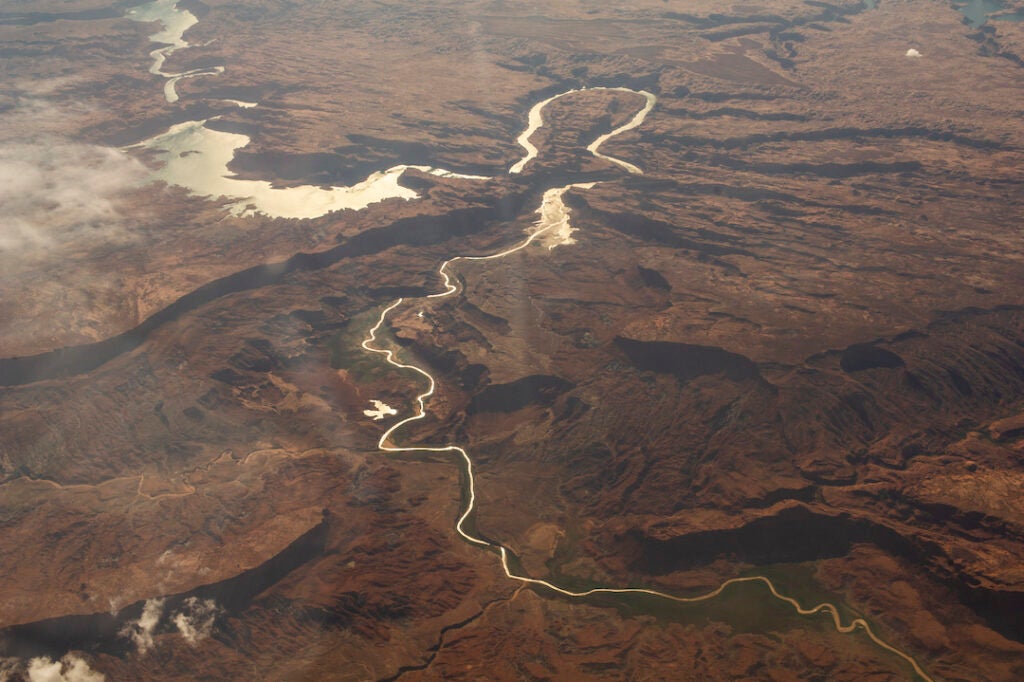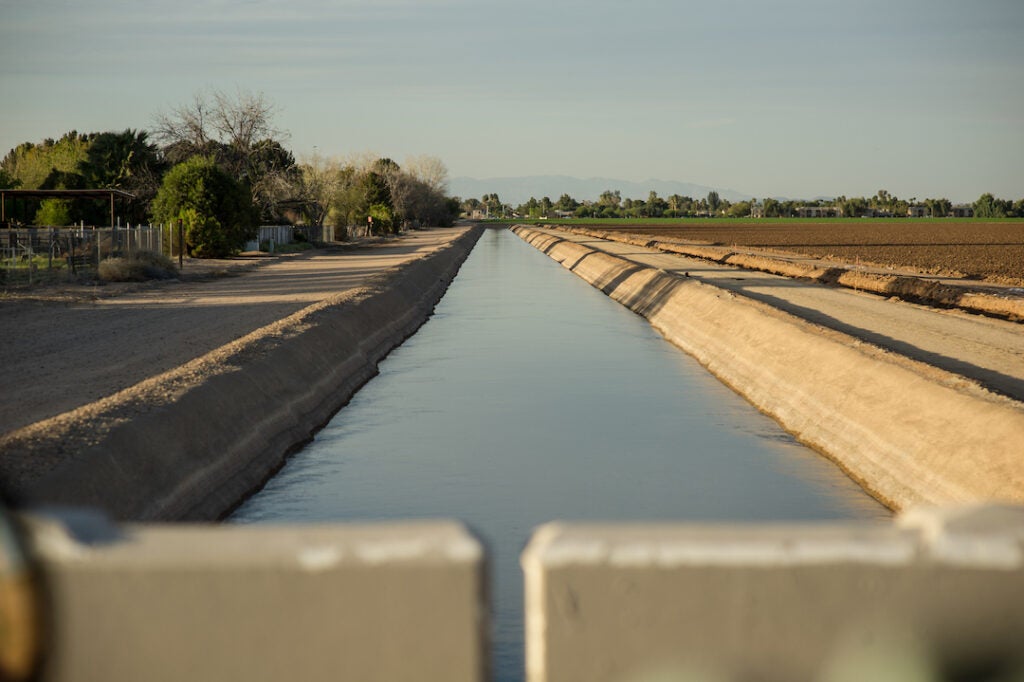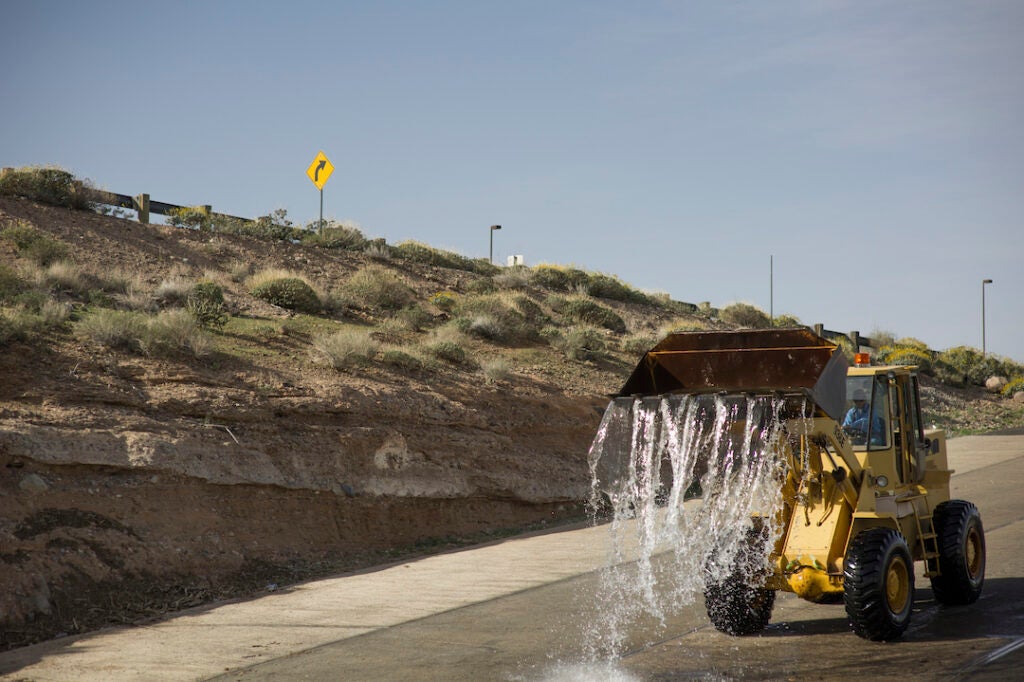The treaty governing the Colorado River turns 100 years old—and faces a fraught future
Author: Kyle Paoletta, Common Home Correspondent
When viewed from above, California’s Imperial Valley appears as a brown and green checkerboard, stretching north from the Mexican border for a half million acres. The juxtaposition is no less jarring on the ground, where every road features a split vantage: on one side, luscious fields of spinach, cabbage, or melon, while across the street, bare dirt bakes under the brilliant sun. Though the Sonoran Desert’s warm winters make its climate ideal for many crops, agriculture is only possible in the Imperial Valley because of the network of canals that ferry water there from the Colorado River, 50 miles to the east.

And the Imperial Valley is far from the only portion of America’s most arid corner that relies on the Colorado. From its headwaters in the Rocky Mountains to the Gulf of California, the river runs for 1,450 miles through seven states, the homelands of 29 tribes, and across one national border. Over the past century, the United States has spent billions of dollars to transform the once mercurial river into a reliable plumbing system providing water for 40 million people and five million acres of agricultural land.
After two decades of unrelenting drought, that system is faltering. On January1st of this year, the first ever mandatory limits to the use of Colorado River water went into effect in response to the massive reservoirs of Lake Mead and Lake Powell falling to below a third of their capacity. John Fleck, the director of the Water Resources Program at the University of New Mexico, says that, while many assume that the explosive population growth of the Southwest is draining its reservoirs, “water use in the Colorado River Basin has been declining for a long time. It peaked in 2002. It just hasn’t been going down fast enough.” Indeed, the climate crisis has prolonged and exacerbating the current drought to the point that some scientists are now labeling the situation with a term that carries a connotation of permanence: aridification.
Are we incentiving people to do the wrong thing through our own policies?
Professor Mark Giordano
In a strange accident of history, this moment of acute crisis just so happens to coincide with the centenary of the signing of the 1922 Colorado River Compact, the document that formally governs the allocation of the river’s water. In 2007, the signatories agreed to interim guidelines that detailed the schedule of mandatory cuts that were activated in January. Those new guidelines will last until 2026, giving the region time to hash out how to adjust their claims to the Colorado, a fraught task given that researchers like the University of Colorado’s Brad Udall now predict the river’s flow will shrink by 20 percent over the next three decades.
Nobody knows quite how the negotiations will shake out. “From an engineer’s or economist’s point of view, the Colorado Basin would probably be seen as a mess and a disaster because you can’t optimize anything,” says Mark Giordano, a Professor of Geography at Georgetown. Still, he notes that the compact has “been functioning for 100 years. What else has functioned for 100 years?” That track record is enough to give a lot of observers cause for hope, both in and outside the region. After all, the Southwest’s attempts to hammer out new revisions to the compact over the next few years will be the first concrete test of America’s ability to adapt to the climate crisis.

So far, the clearest fault line that has emerged in the negotiations is between the Colorado’s urban and agricultural users. Allocations of the river’s water are tracked in acre-feet: the volume of water necessary to flood an acre of land to a depth of one foot. While one acre-foot is enough to sustain three households in a city like Phoenix for a year, growing a single acre of alfalfa, which is cultivated throughout the region, can require more than four feet of water. Cotton is a similarly thirsty plant and is the second-largest crop in Arizona. In 2015, an analysis from ProPublica found that if the state’s cotton farmers switched their fields entirely over to wheat, they would save almost double the amount of water used by the entire Tucson metropolitan area.
All told, as much as 80 percent of the Colorado River is estimated to be devoted to agricultural use. “A few thousand homes are really a small amount of additional water demand compared with a new pecan farm,” says Sarah Porter, the Director of the Kyl Institute for Water Policy at Arizona State University. “If it came down to cities versus agriculture, it’s hard to imagine agriculture winning.”
To her point, the overall decline in the Colorado Basin’s water use is mostly attributable to the astounding efficiency of urban utilities. Between 2007 and 2020, San Diego’s water use declined by almost a third, even as the city added tens of thousands of new residents. Metropolitan Las Vegas, which added more than 300,000 people over the last decade, now recycles 99 percent of the water used indoors.
While cities can treat and recycle wastewater, agriculture faces far greater challenges when it comes to conservation. Josué Medellín-Azura, who leads the Water Systems Management Lab at the University of California, Merced, explains that around 70 percent of the water used on farms is lost to evaporation from soil and transpiration from plants. Even when growers invest in “more efficient, lower volume irrigation infrastructure,” Medellín-Azura says, they’ll often use whatever water they saved to plant more acreage, leading to “an expansion in consumptive use.”

All of this helps to explain why the water cuts that went into effect in January are almost exclusively affecting agriculture. One irrigation district in Arizona’s Pinal County, which lies between Phoenix and Tucson, typically receives 25,000 acre-feet from the Colorado River every year, but in 2022 that group of farmers will only get 8,700. Next year, they probably won’t receive anything from the Colorado at all, making them entirely reliant on the county’s overtaxed reserves of groundwater. “It’s going to be a struggle,” one farmer told the Arizona Republic. “The only chance we have is it needs to rain or snow.”
To prevent these sorts of steep, localized cuts becoming commonplace, Arizona, California, and Nevada announced in December that they’d attempt to stabilize Lake Mead by voluntarily reducing the amount of water they draw from the reservoir this year by 500,000 acre-feet. “If we have the same water year as we had in 2021 than this plan isn’t going to work,” says Andrea Gerlak, a geography professor at the University of Arizona. “If we get lucky, if we get a good couple of water years, then this plan will keep things at bay for a little bit and help push us forward.”
One of the main constituents of the so-called 500-plus imitative is subsidized fallowing, the practice of urban utilities paying irrigation districts to not cultivate some portion of their land — indeed, many of the barren fields of the Imperial Valley have been left that way on purpose, to free up water for urban users elsewhere in California. Through 500-plus, the agency that supplies water to both Los Angeles and San Diego will pay farmers from the Quechan Tribe of the Fort Yuma Indian Reservation in Arizona to fallow their land through 2023, and in December, Arizona Senator Mark Kelly introduced legislation that would allow the Colorado River Indian Tribes, a confederation of Mohave, Chemehuevi, Navajo, and Hopi, to forge similar agreements. Sarah Porter describes fallowing deals as a “win-win, because there’s a reliable revenue stream for the farmer and a reliable water supply for the utility.”
Juggling these competing interests—cities, farms, tribal nations—is no small task. “We didn’t build institutions focused on scarcity,” says Mark Giordano, “we built institutions focused on how you get more water.” To his point, Gary Wockner, the leader of the environmental advocacy group Save the Colorado, is concerned that amid all the wheeling and dealing, the health of the river itself is being overlooked. The Colorado River Delta, which once formed a two-million-acre network of wetlands that was home to hundreds of species, has shrunk to a tenth of its original size. So much water is diverted from the river that, in many years, nothing makes it to the Gulf of California at all. When I asked him about the current negotiations, Wockner observed, “They’re trying to continue their ability to one-hundred-percent drain the river dry, every year.” Instead, he’d like to see 10 percent of the river’s annual flow be set aside to replenish the Delta.

While the 500-plus plan proves the Southwest has some appetite for the slow consensus building that will be necessary to adapt to aridification, it’s difficult to imagine the basin’s leaders stomaching even more drastic cuts being made in the name of conserving the Colorado. Some researchers are likewise concerned that the current agreement is so reliant on fallowing, which Mark Giordano calls “a second or third best solution to the problem.” While fallowing may be a good way “to start moving the process forward,” Giordano wonders, “Are we incentivizing people to do the wrong thing through our own policies? We could change some incentive structures without making farmers worse off that would help them switch to crops that are more sustainable.”
How much flexibility water managers in the Southwest actually end up having remains an open question. As John Fleck points out, the 500-plus plan is based on cutbacks, and “cutbacks that you make to deal with a temporary problem in the midst of climate change have the potential to become repeatable. If Lake Mead keeps dropping, they’ll have to keep finding ways to use less water.” Looking at the current state of the negotiations over the Colorado, Andrea Gerlak can’t help but ask, “Have things really changed? Or is it like water’s leaking out of a hose and you’re trying to patch it with a piece of tape? I don’t think we know yet.”
Correction Feb. 16, 2022: This article has been corrected to specify the water allotment for individuals in the San Carlos Irrigation and Drainage District, rather than the whole county, as well as to amend the initial statement that the Colorado River Compact was meant to expire in 2022.
